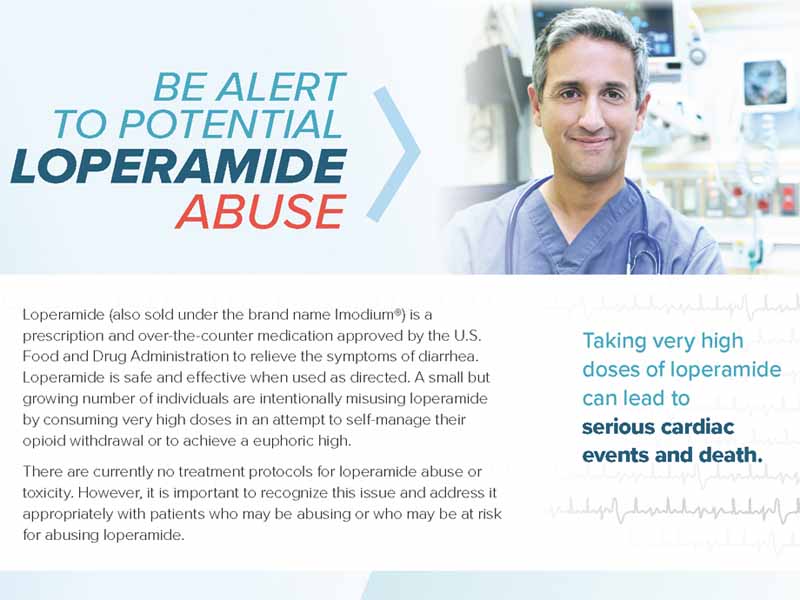Consumer Health Group Warns of Loperamide Abuse, Misuse
January 09, 2019, 08:47 am News Staff – The Consumer Healthcare Products Association (CHPA) wants to ensure family physicians know that improper use of loperamide (Imodium) -- specifically, taking it at very high doses -- can have serious, even fatal, cardiac effects.
In response to this concern, CHPA has launched a Loperamide Safety education campaign that offers clinical resources such as fact sheets for general health care professionals, emergency health care professionals and mental health care professionals, as well as for patients. Additional resources for clinicians include FDA drug safety communications and journal articles and case studies about the drug.
Loperamide is an important FDA-approved antidiarrheal medication sold both in OTC formulations and by prescription that is used safely every day by millions of people, said CHPA.
However, recent data suggest that a small but increasing number of people are taking extremely high doses of loperamide in a misguided attempt to self-manage opioid withdrawal or to achieve a euphoric high.

Through this campaign, CHPA hopes to educate health care professionals about loperamide abuse and how they can help prevent misuse/abuse and support patients who may be at risk.
Story Highlights
About Loperamide
Loperamide is a peripherally acting mu opioid agonist -- specifically, a synthetic opiate that interacts with the opioid receptors in the gut. However, at very high doses, the medication can cross the blood-brain barrier and cause opioid-like effects.
According to CHPA's website, "Nonclinical in-vitro and in-vivo (rabbit, guinea pig) cardiac electrophysiological safety assessments of loperamide support a large safety margin at the labeled dose, but at excessive doses, suggest that loperamide can inhibit the potassium channels (hERG) and cardiac sodium channels, which could result in QT and QRS prolongation and induce arrhythmia."
In humans, the loperamide dose and resulting blood level of the drug that lead to serious cardiac events are unknown, CHPA said. But long-term data from the American Association of Poison Control Centers' National Poison Data System suggest that cardiac effects are typically associated with doses of more than 100 mg, although cases have been reported with doses lower than this threshold.
Available data also show that although loperamide abuse is not currently widespread, it is on the upswing. According to an article in a March/April 2017 supplement to the Journal of the American Pharmacists Association, 54 case reports of loperamide toxicity were published from 1985 to 2016, with 21 cases reported from 1985 to 2013 and 33 from 2014 to 2016. In addition, 179 cases of intentional loperamide misuse were reported to the National Poison Data System between 2008 and 2016, with more than half reported after Jan. 1, 2014.
Patient Profile/Signs of Misuse
CHPA's safety campaign website said the low number of reported loperamide abuse cases and limited data make it difficult to pin down a specific patient profile. However, significant evidence links loperamide abuse to substance use disorder (SUD), and available data suggest that patients most at risk for abusing loperamide likely have a history of substance abuse and/or opioid use disorder. And although men in their late 20s and 30s appear to be more likely than other demographic groups to be diagnosed as abusing the drug, loperamide misuse can affect any gender or age group.
There currently is no screening tool specifically for loperamide abuse, said CHPA, but screening tools for SUD are plentiful, including those provided by the Substance Abuse and Mental Health Services Administration's Center for Integrated Health Solutions.
As for signs of loperamide cardiotoxicity, patients may exhibit
- syncope,
- rapid or irregular heartbeat,
- unresponsiveness,
- QT interval prolongation,
- torsades de pointes,
- ventricular arrhythmias, and/or
- cardiac arrest.
Gastrointestinal complications, including nausea, vomiting, constipation and paralyzed intestine, can also be a sign of loperamide overdose, said CHPA. Family physicians who encounter patients with these or other signs of addiction should include loperamide abuse in the differential.
Preventing Loperamide Abuse
As for prevention, CHPA said family physicians should remember that some patients experiencing opioid withdrawal may turn to loperamide to ease their withdrawal symptoms and remain vigilant for signs and symptoms of loperamide toxicity.
It's also important to note that some patients who are abusing loperamide may combine it with other drugs to increase absorption and penetration across the blood-brain barrier.
The safety campaign website recommends family physicians consider their words carefully when discussing loperamide abuse with patients. Being cautious in their approach will help avoid inadvertently letting a patient know that loperamide can be used to manage withdrawal or achieve a high.
If family physicians suspect loperamide abuse but are not able to administer a confirmatory blood test, CHPA recommends asking patients questions such as the following:
- Have you been taking loperamide?
- How much loperamide do you take and how often?
- Are you aware of the serious heart risks associated with taking very high doses of loperamide?
If patients report using more than the approved dose of loperamide, family physicians should educate them about the risks and refer them to an appropriate source of treatment for SUD. The CHPA patient fact sheet may be helpful in this instance, just as the group's clinician-focused fact sheets can be shared with colleagues and office staff to alert them to this important safety issue.
Related AAFP News Coverage
Opioid Expert Teams Stand Ready to Assist FPs
Program Offers Free Help With Prevention, Treatment, Recovery
(12/19/2018)
CDC Data Show U.S. Life Expectancy Continues to Decline
Suicides, Drug Overdose Deaths Named as Key Contributors
(12/10/2018)
More From AAFP
Chronic Pain Management and Opioid Misuse: A Public Health Concern (Position Paper)
AAFP Chronic Pain Management Toolkit
Addiction Treatment and Care CME for Family Physicians | FREE CME